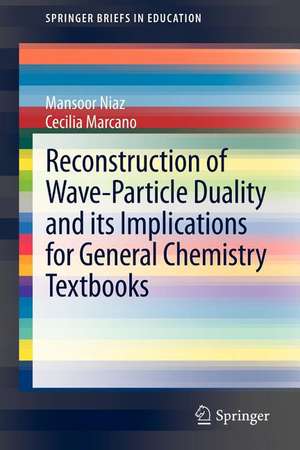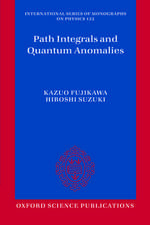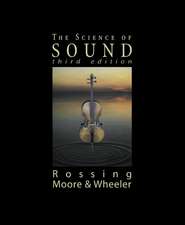Reconstruction of Wave-Particle Duality and its Implications for General Chemistry Textbooks: SpringerBriefs in Education
Autor Mansoor Niaz, Cecilia Marcanoen Limba Engleză Paperback – 27 apr 2012
They come to some revealing conclusions, including the fact that very few textbooks discussed issues such as the suggestion, by both Einstein and de Broglie, and before conclusive experimental evidence was available, that wave-particle duality existed. Other large-scale omissions included de Broglie’s prescription for observing this duality, and the importance of the Davisson-Germer experiments, as well as the struggle to interpret the experimental data they were collecting. Also untouched was the background to the role played by Schrödinger in developing de Broglie’s ideas. The authors argue that rectifying these deficiencies will arouse students’ curiosity by giving them the opportunity to engage creatively with the content of science curricula. They also assert that it isn’t just the experimental data in science that matters, but the theoretical insights and unwonted inspirations, too. In addition, the controversies and discrepancies in the theoretical and experimental record are key drivers in understanding the development of science as we know it today.
Din seria SpringerBriefs in Education
-
 Preț: 317.28 lei
Preț: 317.28 lei -
 Preț: 478.71 lei
Preț: 478.71 lei - 20%
 Preț: 387.44 lei
Preț: 387.44 lei - 17%
 Preț: 392.10 lei
Preț: 392.10 lei -
 Preț: 196.30 lei
Preț: 196.30 lei -
 Preț: 394.41 lei
Preț: 394.41 lei -
 Preț: 356.32 lei
Preț: 356.32 lei -
 Preț: 444.52 lei
Preț: 444.52 lei -
 Preț: 196.15 lei
Preț: 196.15 lei -
 Preț: 262.86 lei
Preț: 262.86 lei -
 Preț: 370.61 lei
Preț: 370.61 lei -
 Preț: 376.59 lei
Preț: 376.59 lei -
 Preț: 379.68 lei
Preț: 379.68 lei -
 Preț: 408.44 lei
Preț: 408.44 lei -
 Preț: 376.22 lei
Preț: 376.22 lei -
 Preț: 378.34 lei
Preț: 378.34 lei -
 Preț: 346.59 lei
Preț: 346.59 lei -
 Preț: 377.18 lei
Preț: 377.18 lei -
 Preț: 377.35 lei
Preț: 377.35 lei -
 Preț: 476.03 lei
Preț: 476.03 lei -
 Preț: 376.43 lei
Preț: 376.43 lei -
 Preț: 379.48 lei
Preț: 379.48 lei -
 Preț: 479.29 lei
Preț: 479.29 lei -
 Preț: 340.61 lei
Preț: 340.61 lei -
 Preț: 377.18 lei
Preț: 377.18 lei -
 Preț: 377.57 lei
Preț: 377.57 lei -
 Preț: 376.59 lei
Preț: 376.59 lei -
 Preț: 377.18 lei
Preț: 377.18 lei -
 Preț: 380.84 lei
Preț: 380.84 lei -
 Preț: 379.09 lei
Preț: 379.09 lei -
 Preț: 354.10 lei
Preț: 354.10 lei -
 Preț: 377.95 lei
Preț: 377.95 lei -
 Preț: 379.68 lei
Preț: 379.68 lei -
 Preț: 377.35 lei
Preț: 377.35 lei -
 Preț: 346.59 lei
Preț: 346.59 lei -
 Preț: 444.52 lei
Preț: 444.52 lei -
 Preț: 376.22 lei
Preț: 376.22 lei -
 Preț: 381.21 lei
Preț: 381.21 lei -
 Preț: 348.13 lei
Preț: 348.13 lei -
 Preț: 409.25 lei
Preț: 409.25 lei -
 Preț: 410.17 lei
Preț: 410.17 lei -
 Preț: 377.57 lei
Preț: 377.57 lei -
 Preț: 380.63 lei
Preț: 380.63 lei -
 Preț: 376.59 lei
Preț: 376.59 lei -
 Preț: 377.57 lei
Preț: 377.57 lei -
 Preț: 380.07 lei
Preț: 380.07 lei -
 Preț: 378.54 lei
Preț: 378.54 lei -
 Preț: 379.48 lei
Preț: 379.48 lei -
 Preț: 377.73 lei
Preț: 377.73 lei -
 Preț: 342.74 lei
Preț: 342.74 lei
Preț: 340.83 lei
Nou
Puncte Express: 511
Preț estimativ în valută:
65.22€ • 69.74$ • 54.38£
65.22€ • 69.74$ • 54.38£
Carte tipărită la comandă
Livrare economică 18 aprilie-02 mai
Preluare comenzi: 021 569.72.76
Specificații
ISBN-13: 9789400743953
ISBN-10: 9400743955
Pagini: 50
Ilustrații: VIII, 46 p.
Dimensiuni: 155 x 235 x 8 mm
Greutate: 0.09 kg
Ediția:2012
Editura: SPRINGER NETHERLANDS
Colecția Springer
Seria SpringerBriefs in Education
Locul publicării:Dordrecht, Netherlands
ISBN-10: 9400743955
Pagini: 50
Ilustrații: VIII, 46 p.
Dimensiuni: 155 x 235 x 8 mm
Greutate: 0.09 kg
Ediția:2012
Editura: SPRINGER NETHERLANDS
Colecția Springer
Seria SpringerBriefs in Education
Locul publicării:Dordrecht, Netherlands
Public țintă
ResearchCuprins
Introduction: A Brief Review of Textbook Analyses based on a History and Philosoph of Science Perspective.- Historical Reconstruction of Wave-Particle Duality.- Criteria for Evaluation of General Chemistry Textbooks.- Evaluation of General Chemistry Textbooks: Results and Discussion.- Conclusions and Educational Implications.- References.- Appendix A List of General Chemistry Textbooks Analyzed in this Study (n=128).- Appendix B Reliability of Evaluation of General Chemistry Textbooks based on Inter-Rater Agreement.
Recenzii
From the reviews:
“‘This study provides science teachers with various historically based presentations which provide the necessary backgorund for improving students’ understanding of wave-particle duality.’ … The book contains a useful set of references for those wanting to read some of the original publications of the early twentieth century and some of the more recent reflective secondary works. … the succinct compilation of historical data is a most useful source for lecturers teaching tertiary chemistry.” (K. C. de Berg, Science & Education, January, 2013)
“‘This study provides science teachers with various historically based presentations which provide the necessary backgorund for improving students’ understanding of wave-particle duality.’ … The book contains a useful set of references for those wanting to read some of the original publications of the early twentieth century and some of the more recent reflective secondary works. … the succinct compilation of historical data is a most useful source for lecturers teaching tertiary chemistry.” (K. C. de Berg, Science & Education, January, 2013)
Textul de pe ultima copertă
It goes without saying that atomic structure, including its dual wave-particle nature, cannot be demonstrated in the classroom. Thus, for most science teachers, especially those in physics and chemistry, the textbook is their key resource and their students’ core source of information. Science education historiography recognizes the role played by the history and philosophy of science in developing the content of our textbooks, and with this in mind, the authors analyze more than 120 general chemistry textbooks published in the USA, based on criteria derived from a historical reconstruction of wave-particle duality.
They come to some revealing conclusions, including the fact that very few textbooks discussed issues such as the suggestion, by both Einstein and de Broglie, and before conclusive experimental evidence was available, that wave-particle duality existed. Other large-scale omissions included de Broglie’s prescription for observing this duality, and the importance of the Davisson-Germer experiments, as well as the struggle to interpret the experimental data they were collecting. Also untouched was the background to the role played by Schrödinger in developing de Broglie’s ideas. The authors argue that rectifying these deficiencies will arouse students’ curiosity by giving them the opportunity to engage creatively with the content of science curricula. They also assert that it isn’t just the experimental data in science that matters, but the theoretical insights and unwonted inspirations, too. In addition, the controversies and discrepancies in the theoretical and experimental record are key drivers in understanding the development of science as we know it today.
They come to some revealing conclusions, including the fact that very few textbooks discussed issues such as the suggestion, by both Einstein and de Broglie, and before conclusive experimental evidence was available, that wave-particle duality existed. Other large-scale omissions included de Broglie’s prescription for observing this duality, and the importance of the Davisson-Germer experiments, as well as the struggle to interpret the experimental data they were collecting. Also untouched was the background to the role played by Schrödinger in developing de Broglie’s ideas. The authors argue that rectifying these deficiencies will arouse students’ curiosity by giving them the opportunity to engage creatively with the content of science curricula. They also assert that it isn’t just the experimental data in science that matters, but the theoretical insights and unwonted inspirations, too. In addition, the controversies and discrepancies in the theoretical and experimental record are key drivers in understanding the development of science as we know it today.
Caracteristici
Historical reconstructions are very different from textbook presentations History and philosophy of science are important sources for motivating students Scientific progress is characterized by theoretical insight, experiments and controversies Wave-particle duality is crucial for understanding modern atomic structure Presentation of wave-particle duality within a historical context can facilitate students’ conceptual understanding Includes supplementary material: sn.pub/extras














